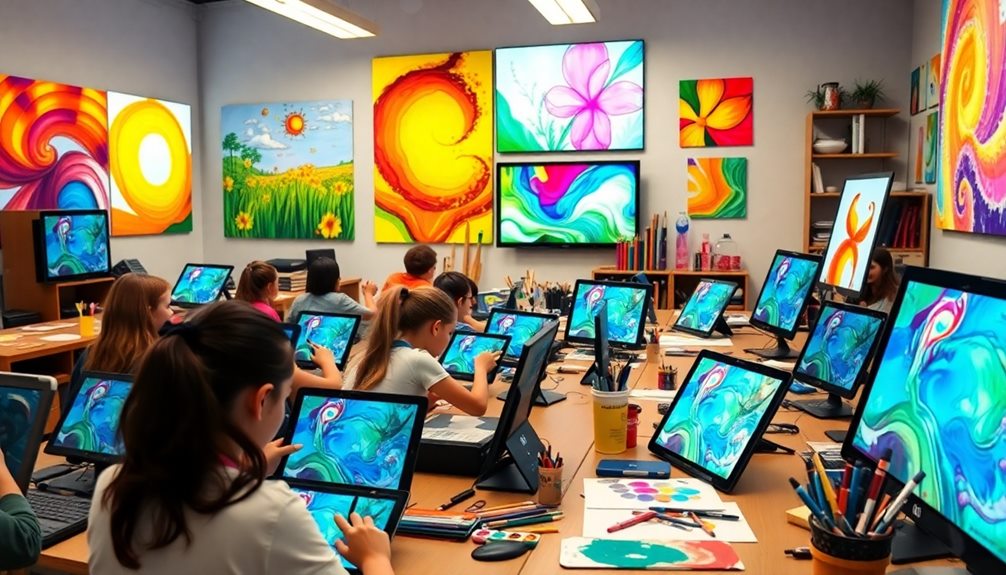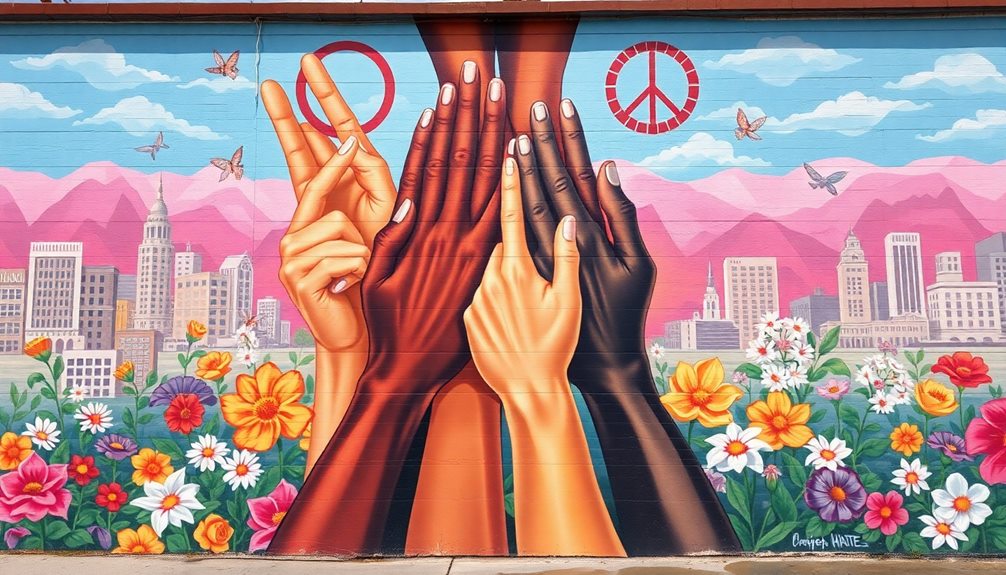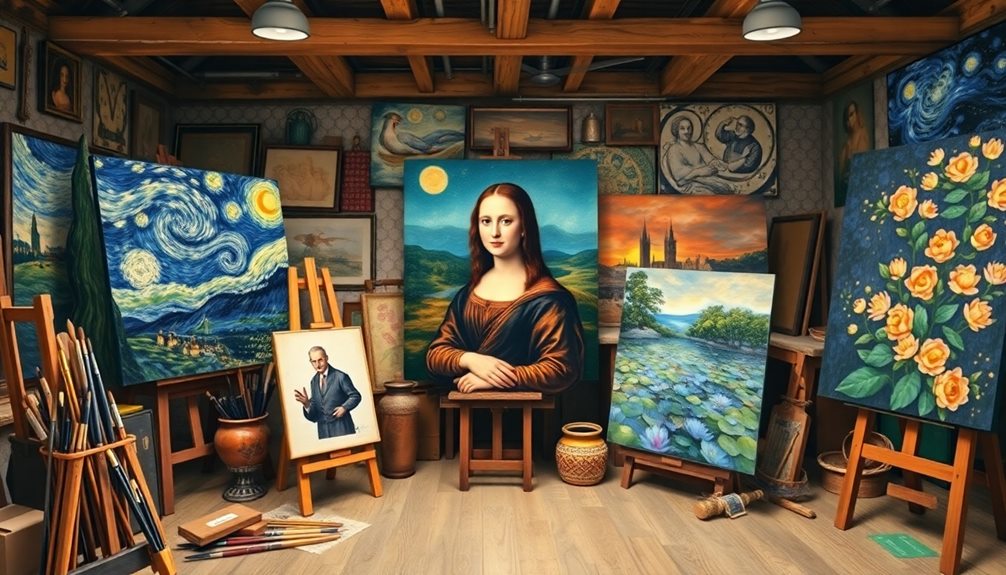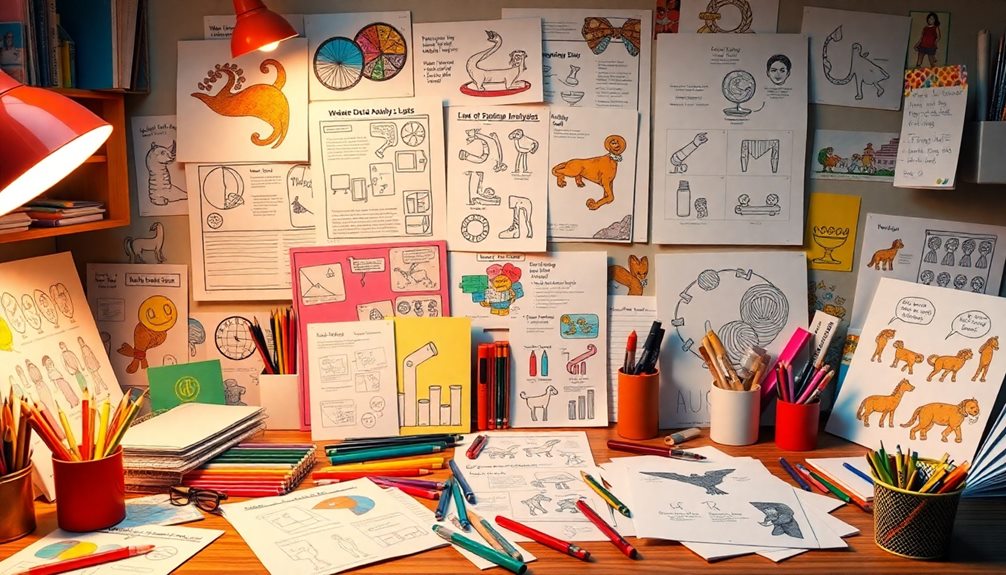To create a concept board for interior design, start by defining your desired style. Gather inspiration from sources like Pinterest and design magazines. Use tools like Canva to upload and manipulate your images, incorporating color swatches, fabric samples, and furniture pictures. Arrange these elements to guarantee a visually appealing layout that reflects your vision. Aim for cohesion by selecting stylish components that blend aesthetics and functionality. Don't forget to evaluate and experiment with different arrangements until you find one that inspires you. There's so much more to explore on how to elevate your design game effectively. Consider creating a mood board to further refine your concept and translate it into a cohesive design scheme. This will involve curating a selection of images, textures, and colors that capture the atmosphere and mood you are trying to achieve in your space. Use this process to fine-tune the details and ensure that every element works harmoniously together in your interior design concept. Ultimately, creating a mood board will help you bring your vision to life in a tangible and visually inspiring way.
Key Takeaways
- Define your desired interior design style to guide your image selection and overall concept.
- Gather inspiration from diverse sources like Pinterest, Google Images, and design publications.
- Use tools like Canva to upload and arrange images, ensuring a cohesive visual layout.
- Incorporate essential elements such as color swatches, fabric samples, and furniture images into your concept board.
- Evaluate and experiment with different layouts to ensure alignment with your overall design vision.
Importance of Mood Boards

Mood boards are important visual tools in interior design, and their significance can't be overstated. They serve as a visual representation of your ideas, helping you communicate your vision clearly to clients and collaborators. By creating mood boards, you clarify your overall vision and style for an interior design project, which reduces misunderstandings and guesswork in discussions.
These design boards provide a cohesive collection of colors, textures, and themes that guide the design process. They allow you to explore different color palettes and adjust elements before implementing them, ensuring that you stay aligned with your intended aesthetic. This exploration is essential for enhancing your creative process, especially if you're a visual thinker.
Moreover, mood boards save you time and resources by allowing you to evaluate design elements thoroughly before committing to them. They keep your project on track, maintaining focus on your inspiration and overall goals.
Fundamentally, mood boards aren't just helpful; they're critical for successful interior design, ensuring clarity and cohesion throughout the project.
Tools for Creating Mood Boards

When creating mood boards, user-friendly design platforms like Canva can make the process a breeze.
You can easily manipulate images and elements with its drag-and-drop functionality, ensuring your ideas come to life effortlessly.
If you want to take your designs further, exploring image editing techniques will enhance your boards even more.
User-Friendly Design Platforms
Creating a visually appealing concept board doesn't have to be complicated. One of the best tools for this purpose is Canva, a user-friendly platform that makes designing mood boards a breeze. With its drag-and-drop interface, you can easily arrange images and elements into beautiful templates, even if you don't have prior graphic design experience.
For those inspired by unique cultural experiences in your designs, Canva can help you capture that essence visually. The free version of Canva offers a wide range of templates and tools, allowing you to craft stunning digital mood boards without breaking the bank.
If you're on a tighter budget, Canva's free version is a fantastic option. However, if you need more advanced features like background removal, consider upgrading to Canva Pro for about $10 a month. While Adobe Photoshop and Illustrator are alternatives, they come with a steeper learning curve and require subscriptions.
Another great way to gather inspiration before creating your mood board is by using platforms like Pinterest. It allows you to collect and organize images efficiently.
Image Manipulation Techniques
A well-crafted mood board relies heavily on effective image manipulation techniques to bring your design vision to life. Incorporating elements from nature can enhance the cozy aesthetic of your board, reminiscent of a Cottagecore Home Office.
Canva stands out as an excellent tool for this purpose, thanks to its user-friendly drag and drop functionality. You can easily arrange stock images and design elements to create a compelling visual layout that speaks to your interior design concept.
In Canva, manipulating images is straightforward. You can resize, rotate, and layer images to enhance your mood board's appeal. If you have Canva Pro, the background removal tool is a game-changer, allowing you to isolate key design elements quickly, making your board more cohesive and professional.
For those using the free version, don't worry! You can utilize free resources like remove.bg to assist with background removal, ensuring your images look polished.
This combination of tools and techniques not only simplifies the design process but also elevates the quality of your mood board, effectively communicating your interior design vision. With these image manipulation techniques, you'll be well on your way to creating an inspiring concept board that resonates with your style.
Gathering Inspiration

Gathering inspiration is an essential step in crafting your interior design concept board. As a visual person, you'll want to collect diverse elements that resonate with your aesthetic, such as those found in modern farmhouse decor trends.
Here's how to get started:
- Create a Pinterest board: This platform allows you to curate a collection of images that inspire you, including textiles, furnishings, and decor elements.
- Utilize Google Images: Search for additional materials and furnishings. Make sure to save links and images in a folder for easy reference during your design process.
- Browse magazines and books: Explore interior design publications to discover trending styles and timeless concepts that you can incorporate into your mood board.
- Visit local thrift stores: These shops often have unique pieces that can serve as focal points or inspire your overall design direction.
As you gather inspiration, regularly review your collected images to streamline your design board.
Focus on elements that align with your established vision and color schemes. By collecting images thoughtfully, you'll create an interior design mood board that truly reflects your style.
Organizing and Tracking Resources

When diving into your interior design project, it's important to keep your resources organized and easily accessible. Start by utilizing a tracking spreadsheet, like Google Spreadsheets, to efficiently manage item links, source information, and pricing. This approach will help you maintain an accurate overview of your project budget throughout the design process.
Next, you can organize your Pinterest pins into dedicated boards for specific projects. This will allow quick access to shopping references and inspiration when needed. Additionally, create a well-structured folder system on your computer to categorize product images. This guarantees you can easily locate and reference materials as you create your mood board.
Here's a simple representation of how you can organize your resources:
| Resource Type | Description |
|---|---|
| Tracking Spreadsheet | Links, source info, pricing |
| Pinterest Boards | Organized project inspiration |
| Folder System | Categorized product images |
Regularly update your tracking resources with new finds and pricing changes. Consider adding columns for notes on item compatibility and estimated delivery times, enhancing your planning and coordination efforts as you work like professional interior designers.
Step-by-Step Mood Board Creation

To kick off your mood board, start by defining your desired interior design style, as this will guide your choices.
Next, focus on image arrangement techniques to create a visually appealing layout that captures your vision.
This foundation will help you build a cohesive and inspiring concept board.
Define Design Style
Defining your design style is essential for creating a cohesive concept board that truly reflects your vision. Start by pinpointing the interior design style you want, such as modern, farmhouse, or eclectic. This direction will guide your choices as you develop your mood board.
Consider incorporating stylish elements like wall clocks that blend aesthetics and functionality, enhancing your overall design.
Follow these steps to solidify your design style:
- Gather Inspiration: Look for images that resonate with your chosen style from sources like Pinterest, magazines, or design websites. Pay attention to colors, textures, and furniture styles.
- Create a Mood Board: Upload your selected images into a mood board template using a tool like Canva. Here, you can easily manipulate and arrange elements to visualize your design concept.
- Incorporate Key Elements: Add essential components like color swatches, fabric samples, and furniture images. This helps create a thorough representation of your intended aesthetic.
- Review and Adjust: Take time to evaluate your concept board. Experiment with different layouts and components until everything aligns with your vision.
Image Arrangement Techniques
Creating a visually appealing mood board starts with effective image arrangement techniques that bring your design vision to life. First, determine your desired interior design style and theme; this will guide your image selection.
Next, upload your collected images to a Canva mood board template. As you begin to arrange images, focus on a cohesive visual arrangement that reflects your overall aesthetic.
Utilize Canva's drag-and-drop functionality to easily adjust photo placements. Experiment with different layouts until you find one that resonates with your design mood boards. Don't forget to incorporate links to sources for each image, making it convenient to reference or purchase items later.
Once you're satisfied with the arrangement, review and fine-tune elements as necessary. This step is essential in ensuring that every aspect of your mood board aligns with your interior design style.
Establishing a Focal Point in Design

Establishing a focal point in your interior design can transform a room from ordinary to extraordinary. A well-defined focal point draws the eye and enhances visual appeal, allowing you to create a cohesive space that feels thoughtfully designed.
Here are some tips for selecting your focal point:
- Choose a standout piece: Consider large furniture items, like a striking sofa or bed frame, that can anchor the room.
- Incorporate decorative elements: Eye-catching art or a unique rug can serve as great focal points, adding character to your design.
- Simplify your design process: Use your focal point as a reference for other design choices, aligning surrounding elements to enhance harmony.
- Avoid visual clutter: A strong focal point minimizes distractions, directing attention and enhancing the room's overall aesthetic.
Keep in mind that in larger spaces, you can incorporate multiple focal points.
Just make sure they complement each other to maintain balance and visual interest.
Whether it's for your home office or living room, a well-placed focal point can elevate your interior design greatly.
Conclusion
Creating a concept board for your interior design project is like releasing a tidal wave of creativity in your space! By gathering inspiration, organizing resources, and establishing a focal point, you're setting the stage for a stunning transformation. Remember, your mood board is your design compass, guiding you to an incredible outcome. So, immerse yourself, have fun, and watch as your vision comes to life in a way you never thought possible!









